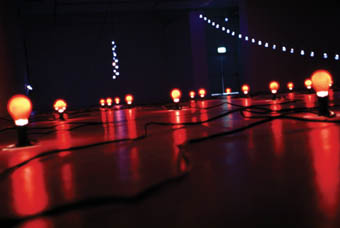Lighting the peripheries
Jena Woodburn

Air Kiss, Steven Carson
photo Lara Thompson
Air Kiss, Steven Carson
Air Kiss’s glowing jumble of deep blue and red light globes dangle in clusters and loop along the walls. Heavy and lovely, lolly-coloured, mouth-shaped, they bloom from the top of columns and drape in strings across the space. Marshalled in corners, each gleaming bulb is linked by a series of wires that spread like secret commands. Yet while they seem to speak of fairs or parties, of Christmas trees and celebrations, beneath their ostensibly cheery appearance courses a vaguely disturbing energy. Contrary to initial impression, the globes are not necessarily celebratory: they could as easily belong to the corpse of a party freshly abandoned as to one waiting to happen.
Traditionally used as decoration, the coloured light globe here is transformed and elevated. As the sole constituent of the work, the globes do not decorate anything—there is nothing to decorate. They enhance nothing, and embellish only empty space. Thus we are welcomed to a floating world of appearances, of deceptive substantiality and ultimately hollow expression. Steven Carson treads a fine line, but successfully. Referring to a world in which style is favoured over substance, he neatly avoids the obvious pitfall of recreating such façadism.
The periodic interruption of the otherwise silent space by an interval of tumultuous music functions to further heighten the viewer’s sense of alienation. All excitement and fanfare, the clamorous crash of bright, harsh, disco-brashness seems to herald some impending event which remains unrealised, its promise unfulfilled. Cut short as unexpectedly as it begins—and before the viewer’s heartbeat has time to calm—this sudden interruption causes the quiet space to reverberate. Its subsequent and abrupt termination results in a resounding disquiet, leaving the space as echoingly hollow as that superficial gesture of affection—as empty as an air kiss.
Such uncertainty enriches Carson’s exploration of the peripheral spaces of mainstream culture and his subsequent manifestation of these metaphorical spaces into literal space. In considering the sub-fields that exist within social life and creative activity, it is to these fringes that both the arts and gay communities—this work was part of the 2002 FEAST Festival—are often relegated. Air Kiss, with its edgy atmosphere of ambiguity, connotes nightclub, brothel and the back alleys of illicit deals and encounters. The sense of seedy glamour—an ambience evoked by its illumination in shades of make-out-room red and druggie-deterrent blue—makes it a place where such ‘alternative’ lives could-can-be lived.
Air Kiss, Steven Carson, Experimental Art Foundation, Adelaide, Nov 21-Dec 20 2002.
RealTime issue #53 Feb-March 2003 pg. 29






